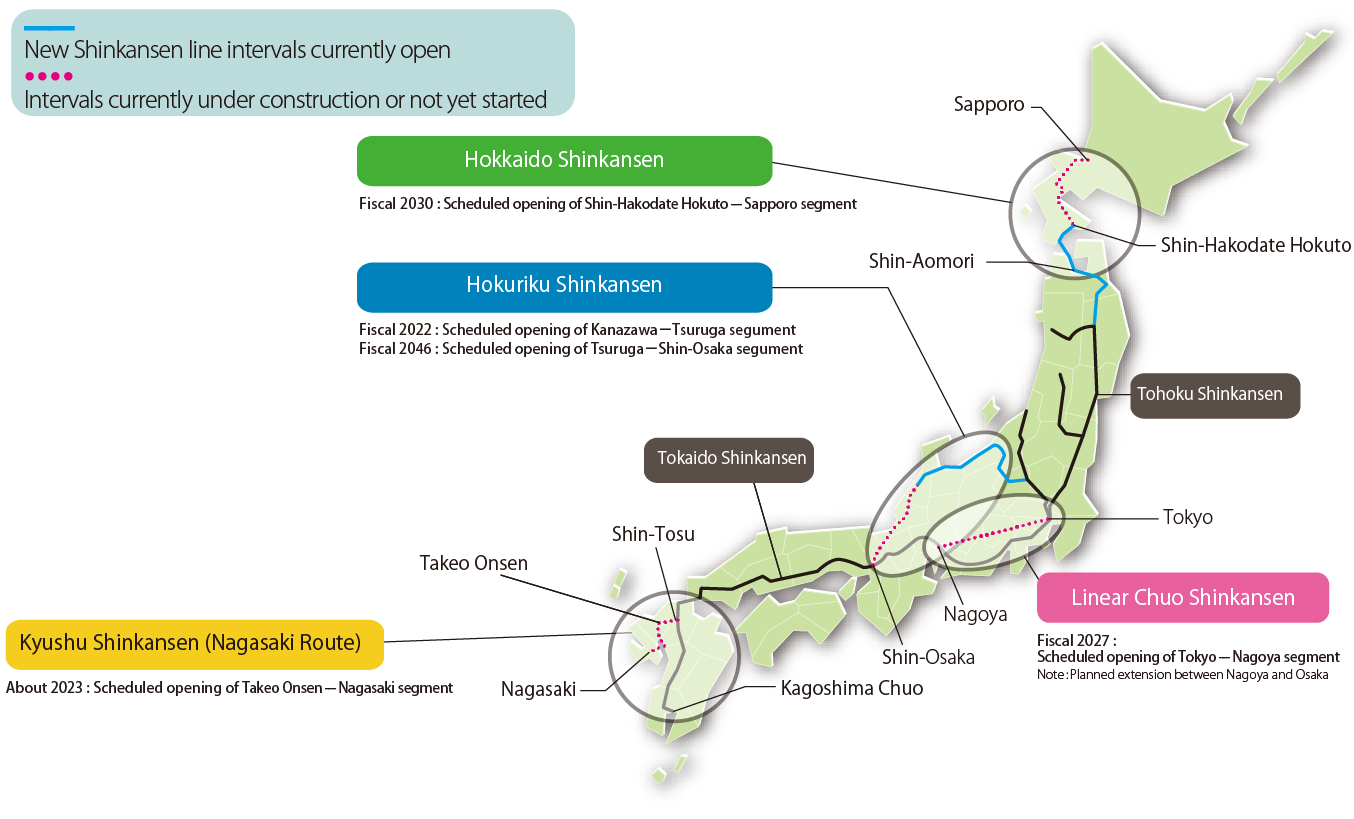Warning: include(/home/c9205967/public_html/kanamoto.ne.jp/include/menu_53annual_en.php): Failed to open stream: No such file or directory in /home/c9205967/public_html/kanamoto.ne.jp/en/pub/53/annualreport/06/index2.html on line 119
Warning: include(): Failed opening '/home/c9205967/public_html/kanamoto.ne.jp/include/menu_53annual_en.php' for inclusion (include_path='.:/opt/alt/php82/usr/share/pear:/opt/alt/php82/usr/share/php:/usr/share/pear:/usr/share/php') in /home/c9205967/public_html/kanamoto.ne.jp/en/pub/53/annualreport/06/index2.html on line 119
Feature

Construction demand for the 2020 Tokyo Olympic Games and railway construction to create Japan’s “transportation axis” go into overdrive
Infrastructure development ahead of the 2020 Tokyo Olympics and Paralympic Games
With projects to build the competition venues for the 2020 Tokyo Olympic Games already underway, full-fledged development of transportation infrastructure to support the event has begun. In addition to the plan to open a new line linking central Tokyo and Haneda Airport, plans are moving forward for a new station between the Shinagawa and Tamachi stations on the Yamanote Line and Keihin Tohoku Line, which will be timed to open for service with the start of the Olympic Games. Development plans for the three ring roads that will be the key to improving transportation efficiency in the Tokyo metropolitan area, including the Tokyo Outer Ring Road (Tokyo-Gaikan Expressway) targeted for completion by about 2020, and the Metropolitan Inter-City Expressway (Ken-O Expressway) that will link each expressway, are moving forward as well.

Japan’s 30-year old utility pole elimination project picks up speed
A utility pole elimination project is currently being pursued in various regions of Japan from the viewpoints of landscape improvement, natural disaster countermeasures, and traffic safety. In fact, this project has an unexpectedly old history. The government took the first steps to relocate wires and cables underground, the most typical method for eliminating utility poles, in 1986, and has been carrying out this effort continuously for over 30 years. In contrast to major cities in Western Europe and Asia, however, where utility pole elimination has largely been achieved, Japan’s efforts to remove such poles lags significantly, with only 8% of all poles having been eliminated in Tokyo’s 23 wards and just 6% in Osaka.
Consequently, the Act Concerning the Promotion of Elimination of Utility Poles was enforced in December 2016. As a result, a new national plan to promote the elimination of utility poles will be move forward, and construction projects to remove poles in various regions will be accelerated, all with an eye on the 2020 Tokyo Olympics.
Status of utility pole elimination in major cities in the United States, Europe, Asia, and in Japan

New Shinkansen routes finalized
New Shinkansen line extension projects are underway in several regions. In addition to the start of construction on the Shin-Hakodate-Hokuto to Sapporo section of the Hokkaido Shinkansen, set to open in FY2030, construction work is also progressing on the Kyushu Shinkansen West Kyushu Route (Nagasaki Route), where operations are slated to begin in FY2022.
Work has also begun on the Kanazawa-Tsuruga section of the Hokuriku Shinkansen, which is scheduled to open in FY2022, while construction is progressing on other works such as the Shin-Hokuriku Tunnel, which will be the sixth longest railway tunnel in Japan once completed, and on the Kuzuryu River Bridge, which will be Japan’s first combined Shinkansen/roadway bridge. Construction between Tsuruga and Shin-Osaka is planned to begin in FY2031, with the aim of opening that route during FY2046.

Full-scale work on Linear Chuo Shinkansen tunnels is underway
Japan hopes to launch Linear Chuo Shinkansen service in 2027. Total expenditures for the immense project have been provisionally calculated to cost between 8.3 trillion to 9.9 trillion yen. Tunnel intervals will account for 246.6km or about 86% of the 285.6km segment between Shinagawa and Nagoya, and full-scale construction of the Southern Alps Tunnel in Yamanashi Prefecture has been underway since December 2015.
In August 2016, Kanamoto launched its Specialized Equipment Engineering Division, and established a Tunnel Machinery Section and Water Treatment Machinery Section in the same division, and is working to strengthen its organization to be able to respond in all directions, in cooperation with other group companies, to the increased work on the new Shinkansen projects, the Linear Chuo Shinkansen, and tunnel-related construction works on each main line route in the future.

Infrastructure development for disaster prevention and disaster mitigation is moving ahead, including large-scale renewal of expressways and bridges
Japan’s infrastructure has reached its renewal period
A wave of antiquated and deteriorating infrastructure is washing over Japan. The need to proceed appropriately with infrastructure maintenance management, and renewal has become an urgent issue, including the occurrence of accidents attributable to aging and deterioration, and expressway management companies are working on renewal plans. The three NEXCO companies will spend about three trillion yen, with just the Shuto Expressway and Hanshin Expressway, both of which are large-scale projects, requiring a combined total expenditure of approximately one trillion yen. In addition, much of Japan’s infrastructure including bridges, river works, drainage and sewage systems, and ports was built through a concentrated effort during the high-economic growth period around the 1960s, and has reached its age for renewal. For example, in 2013 the percentage of roadway bridges that are more than 50-years old was 18%, a figure that will rise to 67% in 2033. Infrastructure maintenance management and renewal expenses will jump in the future, and even when just the structures under the jurisdiction of the Ministry of Land, Infrastructure, Transport and Tourism are considered, are predicted to be 30-50% higher than such outlays currently.
Promoting technology that will help maintain safety
Given such present conditions, public works programs addressing infrastructure upgrades and repairs are already underway in various regions throughout Japan based on The Basic Plan for Extending the Lifespan of Infrastructure, one part of the push for “national resilience” for which the government has announced vast expenditures on the scale of 200 trillion yen.
The Kanamoto Group is actively developing products for infrastructure maintenance and repair as well as new products based on advanced technologies, and introducing products registered in NETIS* (New Technical Information Provision System). In addition, we have prepared an ample lineup of special construction equipment for ground improvement, plus teams of ground improvement specialists at companies within the Group, enabling us to lend a hand for works at locations such as petroleum industrial complexes where deep underground construction work, underwater work, and thorough prevention of ground sinking and subsidence are absolutely essential.
Demand for such specialized engineering works equipment is also vigorous in ASEAN countries, as described on pages 22 and 23. Kanamoto’s construction equipment is on the job not only in Japan, but at overseas infrastructure construction project sites as well.
* Technical information database accumulated based on the Ministry of Land, Infrastructure, Transport and Tourism’s System for Application of Technology in Public Works Etc.

Kanamoto’s “Bridge Dragon” bridge inspection vehicle(center・right)
Expressway Renovation and Repair Plan
| Classification | Length | Cost (100 mil. yen) | |
|---|---|---|---|
| East, Central, and West Nippon Expressway (3 NEXCO companies) | Large-scale renovation | 237km | 17,468 |
| Large-scale repair | 1,872km | 12,597 | |
| Total | 2,109km | 30,064 | |
| Tokyo Metropolitan Expressway | Large-scale renovation | 8km | 3,775 |
| Large-scale repair | 55km | 2,487 | |
| Total | 63km | 6,262 | |
| Hanshin Expressway | Large-scale renovation | 5km | 1,509 |
| Large-scale repair | 57km | 2,176 | |
| Total | 62km | 3,685 |
Source : Prepared based on materials related to the renovation and repair plans announced by each expressway company
Percentage of infrastructure more than 50-years old and future maintenance and renewal costs
| 2013 | 2023 | 2033 | |
|---|---|---|---|
| Road bridges | 18% | 43% | 67% |
| Tunnels | 20% | 34% | 50% |
| River management facilities (floodgates etc.) | 25% | 43% | 64% |
| Drainage/sewerage pipes | 2% | 9% | 24% |
| Harbor quays | 8% | 32% | 58% |
| Maintenance management and renewal costs (estimate result) | 3.6 trillion yen | 4.3-5.1 trillion yen | 4.6-5.5 trillion yen |
Source: Prepared based on Status and Future of Social Capital materials from the Ministry of Land, Infrastructure, Transport and Tourism
A worksite productivity revolution will be achieved through full-scale ICT utilization and conversion to i-Construction
“i-Construction” efforts to accelerate
“i-Construction” seeks to boost productivity by introducing ICT (Information and Communication Technology) to every process at construction worksites, from surveying, design, and construction to maintenance management. The Ministry of Land, Infrastructure and Transport is promoting this measure as one solution to the serious labor shortage problems confronting Japan’s construction industry, such as the decline in the number of young workers and decrease in skilled operators because of the declining birthrate and aging of Japan’s society. “ICT earthmoving” to fully utilize ICT in civil engineering works was implemented earlier in FY2016, and i-Construction efforts aimed at shortening construction periods and manpower savings, including the use of construction machinery equipped with machine control (MC) for road construction works and the start of “ICT paving works” using terrestrial laser scanners, will be accelerated from FY2017.
ICT will help improve natural disaster countermeasures as well
The ICT utilization trend has spread to the national resilience program described earlier as well. In August 2017, Japan’s central government announced a policy to review the Fundamental Plan for National Resilience based on lessons learned from the large-scale disasters that occurred over the past five years. Specifically, the thinking is to position countermeasure enhancements that enable the use of ICT and other advanced technologies to the maximum extent possible as a key pillar of the Fundamental Plan, based on cases where the utilization of technologies such as driverless construction equipment for infrastructure disaster recovery projects has increased.
Kanamoto has already established a special division for information-aided construction and introduced construction equipment for information-aided construction, and is implementing systems operations support. In addition, our New Products Office has developed and introduced a construction equipment remote-control robot that achieves radio-control of general-purpose construction equipment, and in October 2017 we established a new Internet of Things Promotion Section to support the recently growing need for development of equipment that applies IoT-related technologies. Kanamoto will continue to support construction production systems utilizing ICT, which are expected to find even greater applications in the future.

“DOKA ROBO” uses cockpit controllers to remotely operate a two-arm, two-leg humanoid robot placed in the driver’s seat of construction equipment(cnter・right)
Overview of i-Construction

Roadmap for promoting i-Construction (Efforts for utilization of ICT)

Source : Partial excerpt from Efforts to Advance the i-Construction Productivity Revolution at Construction Sites material from the Ministry of Land, Infrastructure, Transport and Tourism